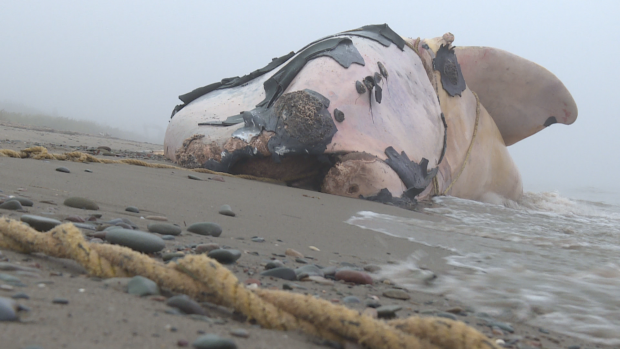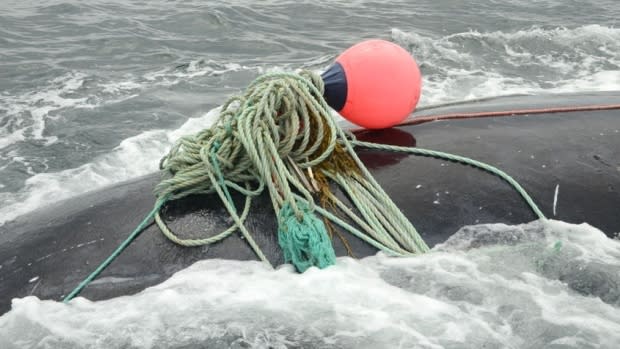Snow crab industry gets $2M to find ways to reduce right whale entanglements
The snow crab industry in northern New Brunswick is getting more than $2 million over three years to implement a series of initiatives designed to reduce the risk of endangered North Atlantic right whales becoming entangled in fishing gear.
The Acadian Crabbers' Association will research and test technologies, such as breakaway gear and ropeless buoys, the federal and New Brunswick governments announced on Tuesday in Shippagan.
Hydrophones will also be used to help track the whales.
"It is imperative to balance preservation of this endangered species with the social, cultural and economic importance of the snow crab fishery in this region," provincial Tourism, Heritage and Culture Minister Robert Gauvin said in a statement, on behalf of Agriculture, Aquaculture and Fisheries Minister Ross Wetmore.
"Many families and communities depend on the snow crab fishery for employment. Co-existence with minimal impact to the North Atlantic right whale population must be achieved."
The announcement comes just two months after the Marine Stewardship Council extended the suspension of its "sustainable" fishing certification for New Brunswick crab products by another year.
Although there were no reported deaths of North Atlantic right whales in the Gulf of St. Lawrence last year after the federal government implemented widespread fishing closures and shipping-speed limits, three whales were found entangled in snow crab gear.
There are only about 411 North Atlantic right whales left in the world, the North Atlantic Right Whale Consortium estimated last fall.
Researchers have reported seeing at least seven calves off the southern U.S. coast, where the mammals spend their winters before coming to Canada, compared to zero last year, buoying hope about the endangered species' survival.
But for the snow crab industry to be recertified, it must show scientific evidence that its fishing activities will not hurt whale recovery efforts.
Ropeless trap testing began last year
The council suspended the industry's certification last year after 12 right whales were found dead in the Gulf of St. Lawrence in 2017. Necropsies on seven of those whales found at least two of the deaths were linked to entanglements, while four died from trauma consistent with vessel collisions.
Robert Haché, executive director of the Acadian Crabbers' Association, could not immediately be reached for comment.
The three-year project was approved for funding in April 2018, but formally announced on Tuesday.

Fishermen began testing ropeless traps last year using two different methods — one based on acoustic release and another that uses an inflatable buoy. Both use sonar to track and communicate with the traps.
Traditional crab traps or pots are loaded with bait and lowered to the ocean floor with a rope and buoy attached to mark their location on the surface.
Right whales tend to spend a lot of time at the surface — coming up to breathe, feed and socialize, so this slack line creates a risk of entanglement, officials have said.
Must adapt to change
The Association des Pêcheurs Professionnels Crabiers Acadiens and the New Brunswick Crabiers du Nord-Est will support the Acadian Crabbers' Association with developing and testing the new technologies.
The initiatives will also help raise awareness among harvesters about the impact of fishing gear, officials said.
"It is imperative to be able to adapt to change to ensure the healthy sustainability of our industry, respect for our marine environment and also to protect the jobs generated by the fishing industry," said Acadie-Bathurst MP Serge Cormier, who attended the announcement on behalf of federal Fisheries, Oceans and the Canadian Coast Guard Minister Jonathan Wilkinson.
Fisheries and Oceans Canada announced a season-long area closure for snow crab and lobster fisheries in the Gulf of St. Lawrence, effective April 28. The so-called static zone is about 63 per cent smaller than last year. It covers the area where the highest concentration of whales was observed during the peak of the 2018 fishing season.
If a right whale is seen in waters between 10 and 20 fathoms, harvesters will be required to move their gear and fish in waters less than 10 fathoms. If a right what is seen in waters less than 10 fathoms, a temporary closure would effectively close the area to the shoreline.

The Fisheries Department also reintroduced mandatory speed restrictions for vessels 20 metres or longer to a maximum of 10 knots when travelling in the western gulf.
The funding for the initiatives announced Tuesday comes from the Atlantic Fisheries Fund, which is jointly funded by Ottawa and the region's provincial governments. It was established in 2017 to help the seafood sector transition to meet growing market demands for products that are high quality and sustainably sourced.
The fund will invest more than $400 million in projects over the seven-year life of the program to support Canada's fish and seafood sector.
Applications are accepted from the commercial fisheries and aquaculture industry, Indigenous groups, universities and academia and industry associations and organizations, including research institutions.
Eligible projects must focus on innovation, infrastructure and science partnerships.

